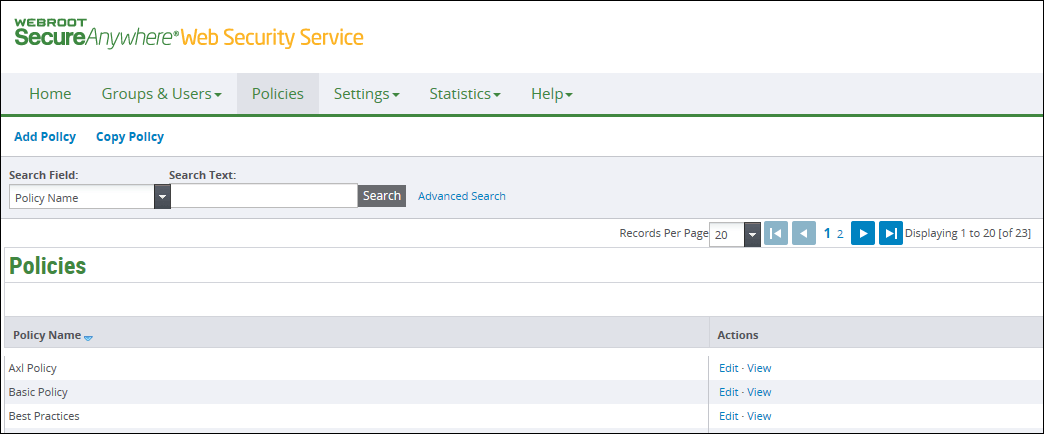Viewing Polices
Policies control access to certain categories of websites. Policies can allow or block access to site categories, or coach users. When users access a coached site, they must identify themselves to continue. Policies can also specify individual URLs to allow or block. Individual URLs to be coached must be assigned to a category that is coached.
The following features are available for policies:
- Default Policies - Web Security Service includes basic configuration settings that you can immediately use and customize if required. Later, you can add your own custom policies to address specific filtering requirements per group.
- Scan-Ahead Capability - This feature displays visual cues or icons to the user on pages that are returned by popular search engines. Based on the policy, the service inserts these icons to the right of the URLs, showing which pages are allowed, blocked, coached, or unknown (not categorized). The Threat icon appears with a warning if the site contains dangerous downloads.
- Heuristic Detection of Phishing Sites - Many sites pose as legitimate financial and banking sites to illegally obtain sensitive personal information from users who access these sites. If a page contains links to what looks like banking and financial URLs, the Web Security Service checks these URLs to see if they are phishing sites, and if so, blocks them. A message states that the site being requested contains Heuristic_Malware.
- Allow, Coach, or Block URLs by Category - Applying a policy to categories of sites saves you from defining one policy for each site. You can also determine the policy for uncategorized sites.
- File Type Filtering - You can allow or block file uploads or downloads according to file type.
- Override Policy for Specific Sites and File Types - After applying category-wide site and file type policies, you can identify specific URLs that are exempt from those policies.
- Safe Search - You can scan and block pornographic images and videos that are returned by search engines.
- Quotas for Web Access - You can define limits to web activity by setting quotas for bandwidth usage, number of sites accessed, and time spent surfing the web. For each quota, resulting actions can include blocking the user if the limit is reached, warning the user if 85% of the limit is reached, and notifying the administrator when a user is blocked.
- Vulnerability Scanning - You can scan desktops and laptops for security updates that are available but that have not been installed. Vulnerability Scanning is automatically enabled for customers who subscribe to Threat Protection or Total Web Protection. Vulnerability Scanning is not available to customers who subscribe only to web filtering.
Default Policies
The Web Security Service default policies include settings that range from the least to the most restrictive. These policies are ready to use, or you can use them as starting points and customize them later to adapt to your business requirements.
- Basic Policy - Has the fewest restrictions.
- Best Practices - Settings are designed to fit most needs. If you add a new policy, the default settings are based on Best Practices. You can edit this policy for new accounts, but you can't delete it.
- Highly Restrictive - Blocks most sites at the main category level, which affects subcategories.
- HR Compliant - Settings promote productivity in the workplace.
- Moderately Restrictive - Has less blocking than the Highly Restrictive policy. Most of the categories have mixed settings.
To view a policy's restrictions:
- Click the Policies tab.
- From the list, locate the policy you want to view.
- In the Actions column, click the policy's View link.
The policy displays in view-only mode. The Management Portal displays the Delete and Edit buttons based on your permission settings or if the policy is used by a group.

- Click on each tab to view the site categories, overrides, and so on.
Protection Levels
Accounts subscribe to one of three levels of protection, based on subscription, that affect the policies you can define. The protection levels are defined in the following table.
| PROTECTION LEVEL |
DESCRIPTION |
| Web Filtering Only |
Enables URL and Web filtering.
- Site Categories and Site Override subtabs are available for configuration.
- Threat protection subtabs (Malware Protection and File) are not available for configuration. By default, detected malware is blocked, and all file types are initially allowed except for files of malicious or suspicious types.
- Default web filtering controls are:
- Blocked - Risk/Fraud/Crime site category except Residential IP subcategory, which is allowed.
- Coached - Pornography/Nudity site category.
- Allowed - All other site categories.
- Quotas are not set.
|
| Threat Protection Only |
Enables protection from malware.
- Malware Protection and Files subtabs are available for configuration. By default, detected malware is blocked, and all file types are initially allowed except for files of malicious or suspicious types.
- Web filtering subtabs (Site Categories and Site Override) are not available for configuration. Traffic to any websites are not filtered in general.
- Quotas are not set.
|
| Total Threat Protection |
Combines Threat Protection and Web Filtering. All subtabs in Policies are configurable. |
Note: Vulnerability Scanning is automatically enabled for customers who subscribe to Threat Protection or to Total Web Protection. Vulnerability Scanning is not available to customers who subscribe only to Web filtering.



